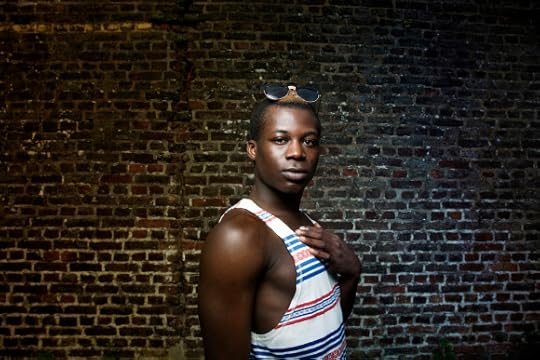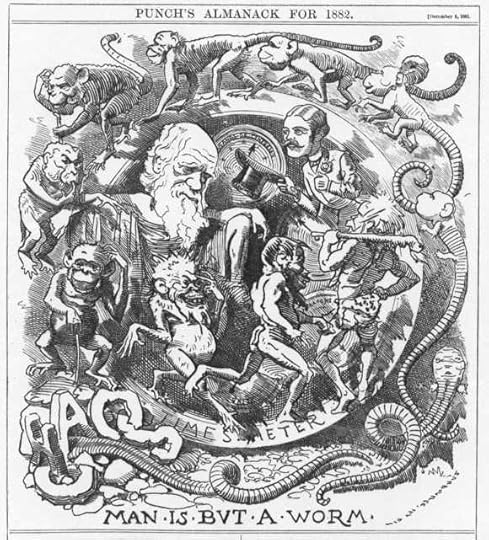Andrew Sullivan's Blog, page 105
November 2, 2014
Mental Health Break
Quote For The Day II
“To those who know a little of Christian history probably the most moving of all the reflections it brings is not the thought of the great events and the well-remembered saints, but of those innumerable millions of entirely obscure faithful men and women, every one with his or her own individual hopes and fears and joys and sorrows and loves — and sins and temptations and prayers — once every whit as vivid and alive as mine are now. They have left no slightest trace in this world, not even a name, but have passed to God utterly forgotten by men. Yet each one of them once believed and prayed as I believe and pray, and found it hard and grew slack and sinned and repented and fell again. Each of them worshipped at the eucharist, and found their thoughts wandering and tried again, and felt heavy and unresponsive and yet knew — just as really and pathetically as I do these things. There is a little ill-spelled ill-carved rustic epitaph of the fourth century from Asia Minor: — ‘Here sleeps the blessed Chione, who has found Jerusalem for she prayed much’. Not another word is known of Chione, some peasant woman who lived in that vanished world of christian Anatolia. But how lovely if all that should survive after sixteen centuries were that one had prayed much, so that the neighbours who saw all one’s life were sure one must have found Jerusalem! What did the Sunday eucharist in her village church every week for a life-time mean to the blessed Chione — and to the millions like her then, and every year since then? The sheer stupendous quantity of the love of God which this ever-repeated action has drawn from the obscure Christian multitudes through the centuries is in itself an overwhelming thought,” – Dom Gregory Dix, The Shape of the Liturgy.
(Hat tip: Wesley Hill)









Face Of The Day
American photographer M. Sharkey captured images of young gay Belgians, including Leroy, above, for his 2013 series “Brussels Is Burning.” According to Jordan G. Teicher:
[Sharkey] found a “totally different youth culture” where queer youths were “not as open about their sexuality at such a young age as Americans are.” “Western Europe is an incredibly modern and connected culture, but the young people—the 14-, 15-, 16-year-old kids—still don’t have a community the way that American kids have,” he said.
See more of Sharkey’s work here, or catch his exhibit “Queer Kids” at the Stonewall National Museum and Archives through January 4.









Worshipping With Warhol
Mark Judge reminds us that the artist was a serious Catholic:
Andy Warhol’s family was Byzantine-Ruthenian, and in the early 20th century they came to America, settling in a Catholic section of Pittsburgh. Warhol’s mother Julia was deeply pious, attending St. John Chrysostom Byzantine Catholic Church. She took her children to Mass, and encouraged Andy, who was sick a lot as a child, to learn how to draw. Warhol drew pictures, went to church, and cut out magazine pictures of movie stars. In those three elements we find his entire life’s work.
Warhol moved to New York in 1949. He then went on to become the most famous artists of the latter 20th century. Warhol is associated with irony, disco, Pop Art paintings of everyday objects like Campbell’s soup cans, and cool. But he never lost the faith. Even during his high-flying Studio-54 days, Warhol would appear at Mass at St. Vincent Ferrer several mornings a week — and as a volunteer at soup kitchens. When his mother moved to New York to live with him, Warhol would warn visiting guests not to curse. Warhol also paid for his nephew to go through seminary and become a priest.
A good, if rare, overview of Warhol’s faith is Jane Daggett Dillenberger’s book The Religious Art of Andy Warhol. There is an entire section dedicated to the over one hundred drawings Warhol made of the Last Supper. When Warhol died in 1987, his eulogist John Richardson said that there were “two Andy Warhols” — the whimsical Pop Art celebrity and the shy and pious Christian.
(Video: Warhol biographer Bob Colacello discusses the reissue of his Factory memoir, Holy Terror: Andy Warhol Close Up)









The Force Is With Them
In the UK’s 2001 Census, 390,127 people, or just under 1% of the population, identified their religion as “Jedi” – though it’s fair to assume not everyone who replied that way was serious. Tom de Castella updates us on the trend, claiming that what began “as an intellectual exercise by fans adding to the movies and filling in the gaps, has become an attempt to build a coherent religious code”:
Beth Singler, a researcher in the Divinity Faculty of Cambridge University, estimates that there are about 2,000 people in the UK who are “very genuine” about being Jedi. That’s roughly the same number as the Church of Scientology, she says. Jediism is not a joke for them but an inspiration. They don’t believe in “A long time ago in a galaxy far, far away…”, says Singler quoting the opening text that fills the screen of Star Wars. “It’s somewhere between metaphor and literal truth.”
“Feel the force” has become a rather tired cliche. But behind it is a New Age mysticism similar to many of the “holistic” ideas that emerged in the 1960s and 70s. “The Force is what gives a Jedi his power,” says Obi-Wan Kenobi, played by Alec Guinness, who initiates young men into Jedi tradition. “It’s an energy field created by all living things. It surrounds us and penetrates us. It binds the galaxy together.”
The Jedi belief system is a patchwork quilt of Taoism, Buddhism, Catholicism and Samurai, says Singler. Often the ideas offer a simple dualism of good and evil, light and dark. “Fear is the path to the dark side,” Yoda tells Anakin Skywalker. “Fear leads to anger. Anger leads to hate. Hate leads to suffering. I sense much fear in you.”









Stalling For Time
Stacey D’Erasmo waxes nostalgic for the days before the Internet ushered in a sort of “virtual eternity”:
I feel weird—sometimes giddy, sometimes nauseous—about time these days. Like many people, I stood in line for hours to become immersed in Christian Marclay’s 2010 art installation, “The Clock,” a twenty-four-hour montage of film clips that synchronized onscreen time—conveyed via images of various timepieces—with actual time. Oddly, vertiginously, although the time onscreen was identical to the time on the street, no matter if one watched for an hour or five one left the theatre feeling as if time had come unsprung, as if one had been plunged into another dimension, a great vertical depth, that made real time seem mysteriously thin and weightless. Lines snaked around blocks to see “The Clock”; some people camped out in sleeping bags overnight outside venues where it was to be shown in order to be first on line. It was a brilliant work of art, but the overwhelming hunger for it suggests that there is a widespread nostalgia for the dominance of clock time, akin to the rise of the nature special as species were disappearing at a rapid rate from the planet. There are more clocks than ever—clocks on computers, on cell phones, on televisions, on any screen available, telling time to the digital second—but they all seem to matter less. Sometimes, the time looks like one more graphic element on a buzzing surface crammed with them, a vestigial bit of design, like watch pockets on jeans.
(Video: Excerpt from Christian Marclay’s “The Clock”)









Darwin And The Divine
Drawing from his new book, Darwin’s Dice: The Idea of Chance in the Thought of Charles Darwin, Curtis Johnson pushes back against an understanding of Darwin’s thinking about God that holds “he gradually shifted from ‘early orthodoxy’ to a ‘liberal form of theism,’ and then in later years ‘into an agnosticism tending at times toward atheism'”:
It seems probable that his departure from Christian faith was earlier, more abrupt, and more complete than this view indicates. The reason for thinking so stems from the same source that so many of Darwin’s contemporaries rejected a role for chance in nature’s workings: a chance-governed world seems tantamount to a godless world. Einstein made this very connection himself 75 years later when he famously said, “God does not play dice with the universe.” Darwin undoubtedly understood this implication of his theory, but rather than conclude that chance plays no role in nature he appears to have concluded instead that God does not have much to do with nature at all.
He goes on to excerpt a telling letter Darwin wrote to the Harvard botanist Asa Gray in May 1860, just a few months after the publication of The Origin of Species:
With respect to the theological view of the question; this is always painful to me.—I am bewildered.—I had no intention to write atheistically. But I own that I cannot see, as plainly as others do, & as I shd. wish to do, evidence of design and beneficence on all sides of us. There seems to me too much misery in the world. I cannot persuade myself that a beneficent & omnipotent God would have designedly created the Ichneumonidae with the express intention of their feeding within the living bodies of caterpillars, or that a cat should play with mice. Not believing this, I see no necessity in the belief that the eye was expressly designed. On the other hand, I cannot be contented to view this wonderful universe, and especially the nature of man, & to conclude that everything is the result of brute force. I am inclined to look at everything as resulting from designed laws, with the details, whether good or bad, left to the working out of what we may call chance. Not that this notion at all satisfies me. I feel most deeply that the whole subject is too profound for the human intellect. A dog might as well speculate on the mind of Newton.—Let each man hope and believe what he can.
(Image: Punch’s almanac for 1882, published shortly before Darwin’s death, depicts him amidst evolution from chaos to Victorian gentleman with the title “Man Is But A Worm,” via Wikimedia Commons)









Not With A Bang, But A Bubble
That’s how cosmologist Alex Vilenkin explains the way the universe will end:
All of a sudden a tiny little bubble will appear. It can appear anywhere—under your chair, or somewhere in Andromeda, very far away—and this little tiny thing starts growing at a speed that’s pretty close to the speed of light. And as it expands, all things that it engulfs turn into an alien form of matter. It may be approaching us right now. Say it nucleated at Andromeda some millions of years ago, it may be expanding toward us at the speed of light. But we don’t get much of a warning. So the good thing about it is you don’t really have to worry about it.
So what would happen to the Earth? It would just go, “FLOOP!” and not exist anymore?
Yeah. Inside of this bubble, ordinary matter as we know it does not exist. It’s made up of different kinds of particles. So everything will be turned into some other stuff that we just don’t know about. But aside from the fact that the end will come very quickly, the other piece of good news is that the probability of the universe ending at any given moment is extremely low.
Like how low?
We can’t really tell. It depends on particle physics at very high energy, so we can’t reliably calculate it. But back-of-the-envelope estimates give you extremely low numbers, like trillions and trillions of years from now. The probably of it occurring while our sun is still active and burning is almost nil. So most likely it will happen when the sun is already gone and, you know, we might not be around.
(Photo by Jim Trodel)









The View From Your Window
Evangelical Heresies
Kevin P. Emmert relays the results of a new survey showing that “[m]ost American evangelicals hold views condemned as heretical by some of the most important councils of the early church.” One example? 22% claim God the Father is “more divine” than Jesus:
No doubt, phrases like “only begotten Son” (John 3:16) and “firstborn of all creation” (Col. 1:15) have led others in history to hold these views, too. In the fourth century, a priest from Libya named Arius (c.250–336) announced, “If the Father begat the Son, then he who was begotten had a beginning. … There was a time when the Son was not.” The idea, known as Arianism, gained wide appeal, even among clergy. But it did not go unopposed. Theologians Alexander and Athanasius of Alexandria, Egypt, argued that Arius denied Christ’s true divinity. Christ is not of similar substance to God, they explained, but of the same substance.
Believing the debate could split the Roman Empire, Emperor Constantine convened the first ecumenical church council in Nicaea in A.D. 325. The council, comprising over 300 bishops, rejected Arianism as heresy and maintained that Jesus shares the same eternal substance with the Father. Orthodoxy struggled to gain popular approval, however, and several heresies revolving around Jesus continued to spread. At the second ecumenical council in Constantinople in 381, church leaders reiterated their condemnation of Arianism and enlarged the Nicene Creed to describe Jesus as “the only-begotten Son of God, begotten of the Father before all worlds, Light of Light, very God of very God, begotten, not made, being of one substance with the Father, by whom all things were made.” In other words, the Son is not a created being, nor can he be less divine than the Father.
Matthew Block, commenting on these findings, blames the prevalence of such heresies on the way many Protestants read the Bible:
Too many Christians mistake “Scripture alone” as if it were a license for them to read the Bible alone—to read it apart from other people. You know the idea: “All I need is me and my Bible.” But that’s not what it means. It means that Scripture is alone authoritative, not that your personal (“alone”) interpretation of Scripture is authoritative.
While Scripture itself is clear on matters of salvation, it nevertheless can be (and often is) misinterpreted by sinful people. Jesus Himself faced this danger when the devil suggested to him misinterpretations of the Word of God (Matthew 4:5-6). We fool ourselves if we think we are somehow exempt from this danger. Christ, of course, did not fall for the devil’s suggested misreading. Unsurprisingly, the Word of God made Flesh knows the written Word of God better than does Satan. But we on the other hand can and do fall into such error—be it error suggested by our own sinful minds, the errant teachings of others, or, indeed, by the devil himself.
Personal piety and a desire for truth are not guarantees that we always read Scripture aright. Consequently, we must rely upon our brothers and sisters in the faith to correct and rebuke us when we err, demonstrating our errors by Scripture (2 Timothy 3:16). And this reliance on brothers and sisters refers not merely to those Christians who happen to be alive at the same time as us. Instead, it refers to the whole Christian Church, throughout time. We rely on those who have gone before us. They too get a say in the matter. As G. K. Chesterton has wonderfully put it, this sort of tradition is a “democracy of the dead.”









Andrew Sullivan's Blog
- Andrew Sullivan's profile
- 153 followers























